Take a trip along the ecliptic from dusk till dawn to check out the sights along this well-traveled highway — the zodiacal light, Mercury, and the gegenschein, plus scenic detours to a comet and an asteroid.
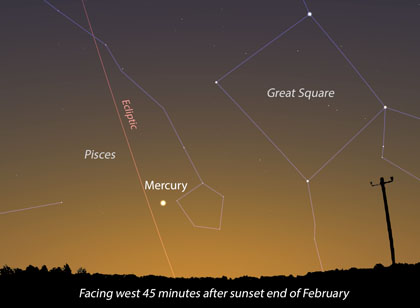
Stellarium
Monday night, I was at a loss to describe the unearthly beauty of the zodiacal light. It towered in the western sky just after 7 p.m., brighter than the Milky Way, which formed a parallel arch off to the northwest. Luminous plume? Like a comet's tail? Then it hit me this morning while half-snoozing in bed — the image of moonlight pouring through a window and spilling onto the floor of a darkened room. It had that same subdued but surprising radiance that makes you stop in your tracks and let out one of those long, involuntary "whoas."
I watched the towering pillar for maybe a half-hour before the bitter cold, –15°F air numbed my fingertips, forcing me to seek refuge inside my car. Cold or no, this is a great time to see the zodiacal light. Like me, you may have to make drive to the countryside for the best view. It's worth it. Even from the northern U.S., the great shaft of light measures 30° wide at its base and stands 60° high. I thrust my gloved fist to the sky and just kept counting — 1 fist, 2 fists, up and up, all the way to the Pleiades and almost to the meridian.
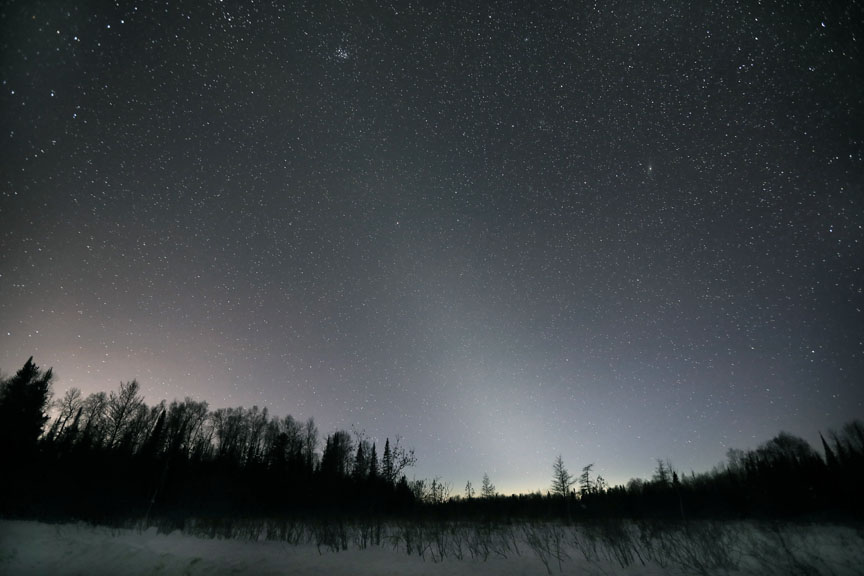
Bob King
The zodiacal light is made of next to nothing, and yet it's one of the largest entities in the solar system. Composed of dust deposited by vaporizing comets and released during asteroid collisions, it suffuses the plane of the solar system from the vicinity of the Sun to at least as far as Jupiter. No wonder it appears so gigantic. But its components are teeny tiny, no bigger than a tenth of a millimeter. Like chalk dust or cigarette smoke, they excel at scattering sunlight. Together they fashion a glowing shaft of light centered on the ecliptic beginning at the western horizon and tilting to the south.
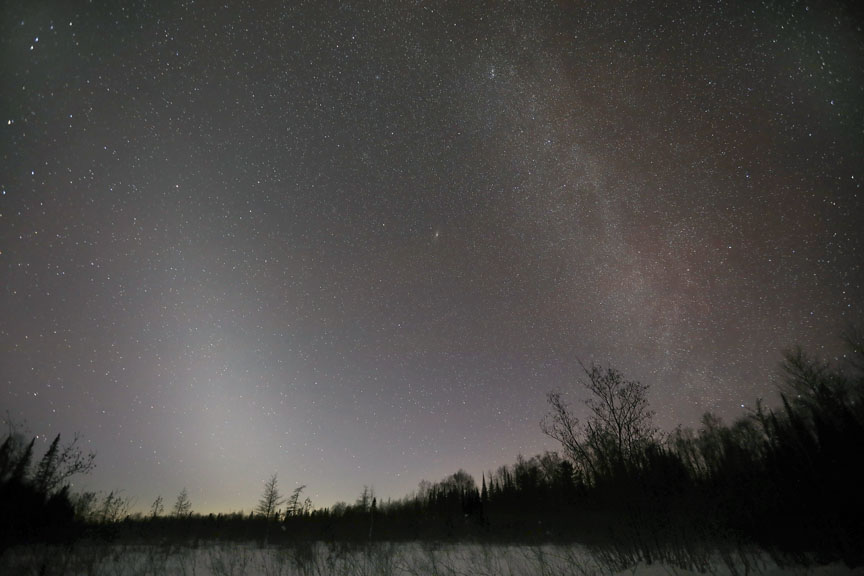
Bob King
Now through March 7th would be ideal for making a zodiacal light excursion. You'll need a dark sky with a wide-open view to the west. It's visible even before the end of twilight, but the best views begin immediately at twilight's end and last for about an hour. Twilight for many mid-northern locales lasts about 1 hour 40 minutes, so start watching about 90 minutes after sunset. To plan your session, click here to find the time of local sunset. If clouds interfere, the next good observing window will be from March 21st through April 5th. To capture a photo, use your widest angle lens, open up to f/2.8 and expose for 30 seconds at ISO 2000–2500.
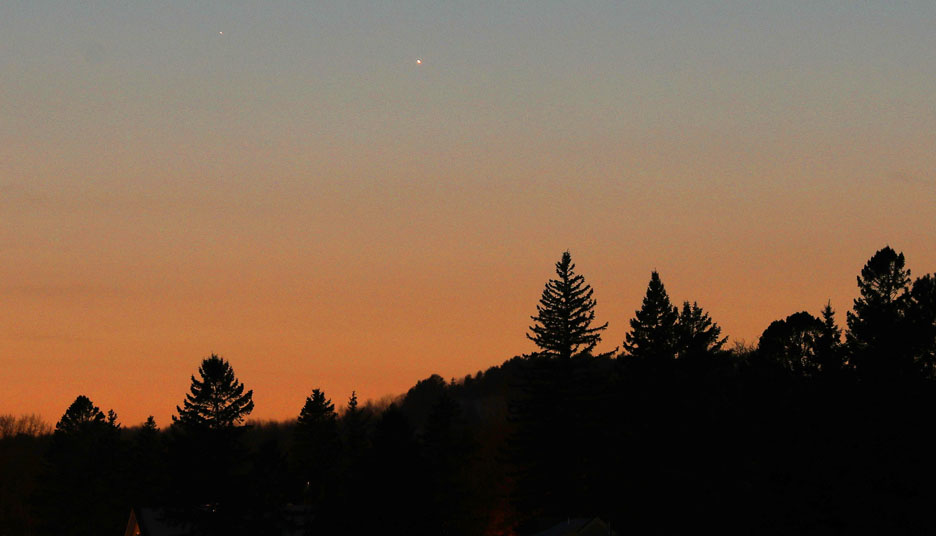
Bob King
On my way to dark skies I was delighted at how easy it was to see Mercury, another zodiac inhabitant. Located just below the Circlet in Pisces, the planet is currently near greatest eastern elongation, shining at magnitude –0.4 about 10° high in the west 45 minutes after sunset. As long as high clouds don't muss the view, you simply can't miss it. I followed Mercury to within 2° of the horizon at the base of the zodiacal light on February 25th. The planet holds a steady position into early next week before quickly fading and losing altitude.
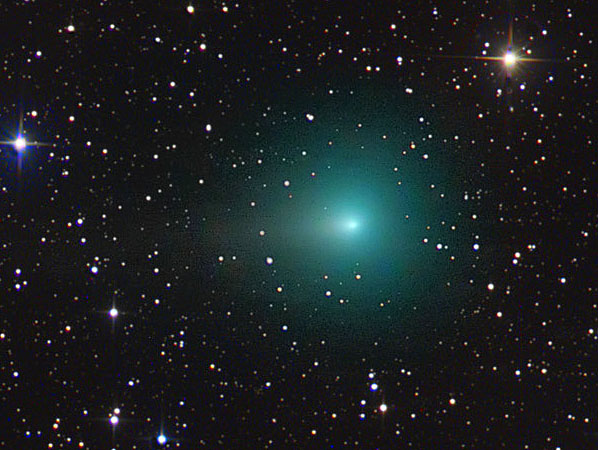
Chris Schur
Let's stray from our zodiacal path for a moment to check in on Comet Iwamoto (C/2018 Y1). The coming week before the moon returns will be the last for easy views of this diffuse object. I nabbed in 10×50 binoculars on February 26.1 UT as an 8th-magnitude fuzzy spot 15′ (arcminutes) in diameter with a slightly brighter center. Through my 10-inch Dob at 64× I estimated 12′ across with a DC (degree of condensation) of 4.
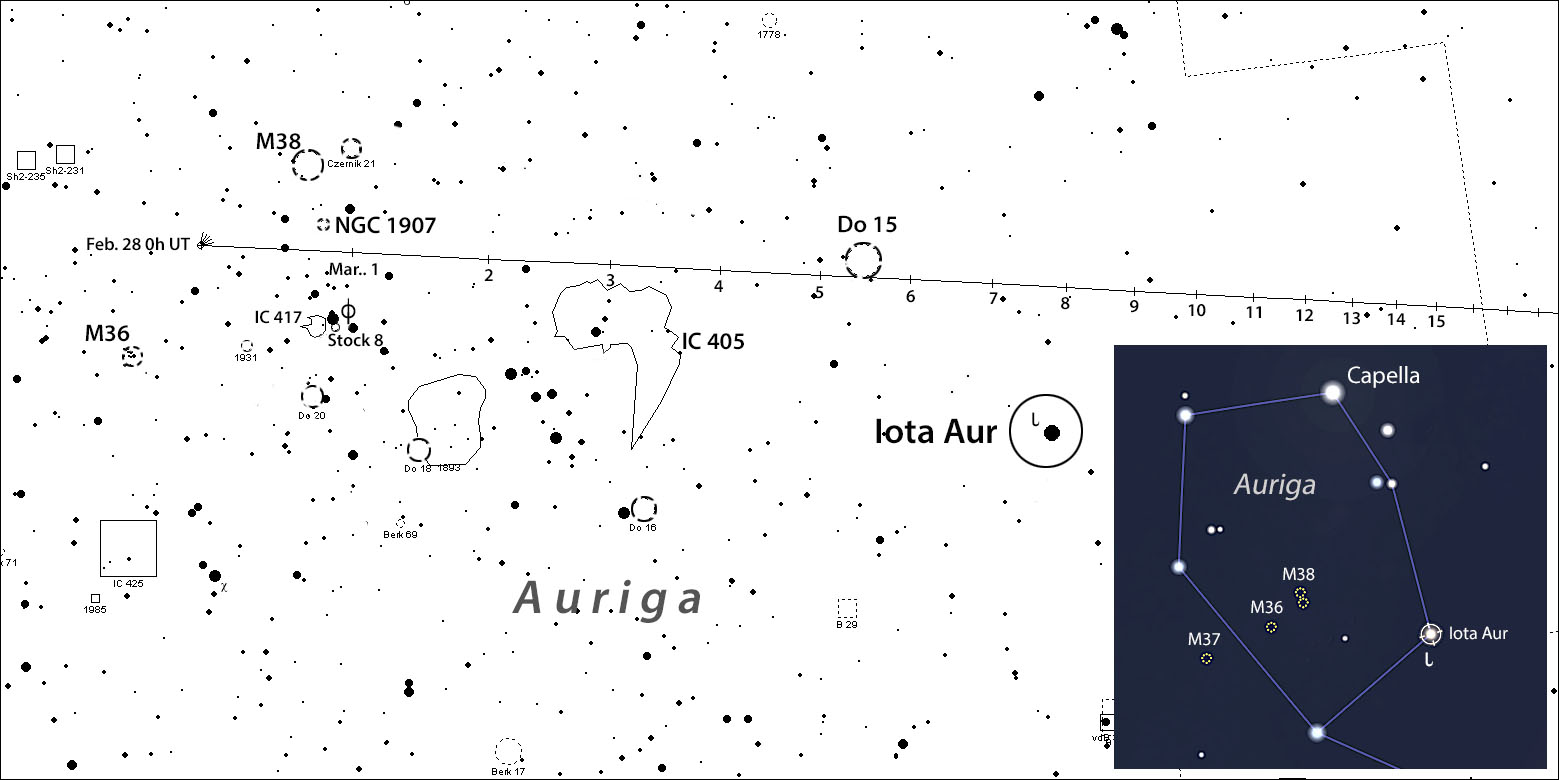
Chris Marriott's SkyMap
The most difficult thing about the comet is its location in Auriga, which is currently near the zenith during early evening hours. When using binoculars I've had to lie on my back in the snow because my neck is no longer up to the challenge! Auriga's a happy place for a comet because it's rich in star clusters. Watch tonight (February 27th) as the comet glides between M36 and M38, and again on February 28th, when it lines up within 1° of M38 and NGC 1907. Lots of great astrophotography opportunities here. Iwamoto is expected to fade quickly in the next couple weeks, so catch it soon.
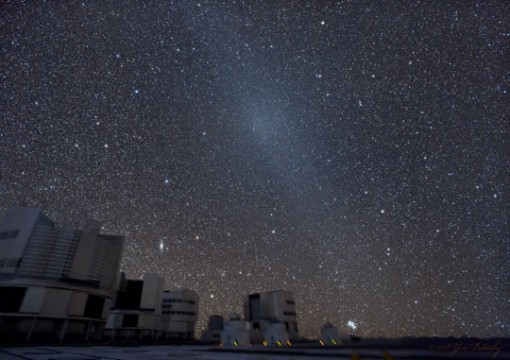
ESO / Yuri Beletsky
The gegenschein is the zodiacal light's fainter cousin. It also lies on the ecliptic but opposite the Sun, so it's highest in the sky around local midnight (1 a.m. Daylight Saving Time). After finally identifying the gegenschein some years ago, I've become so familiar with its appearance, I can see it most nights from my dark sky site (Bortle Class 3) unless it's low in the sky or passes in front of the Milky Way. The name, pronounced GAY-gun-shine, is German and means "counter-glow."
Although few of us see it because it requires the darkest of skies, the zodiacal light narrows at its tip and extends all the way around the sky to the opposite horizon in a narrower ribbon called the zodiacal band. The gegenschein is a brighter patch in the band about 8° wide and 6° thick. It stands out because the dust is located at the anti-solar point and backscatters sunlight, boosting its brightness the same way Saturn's rings brighten around opposition due to the opposition effect.
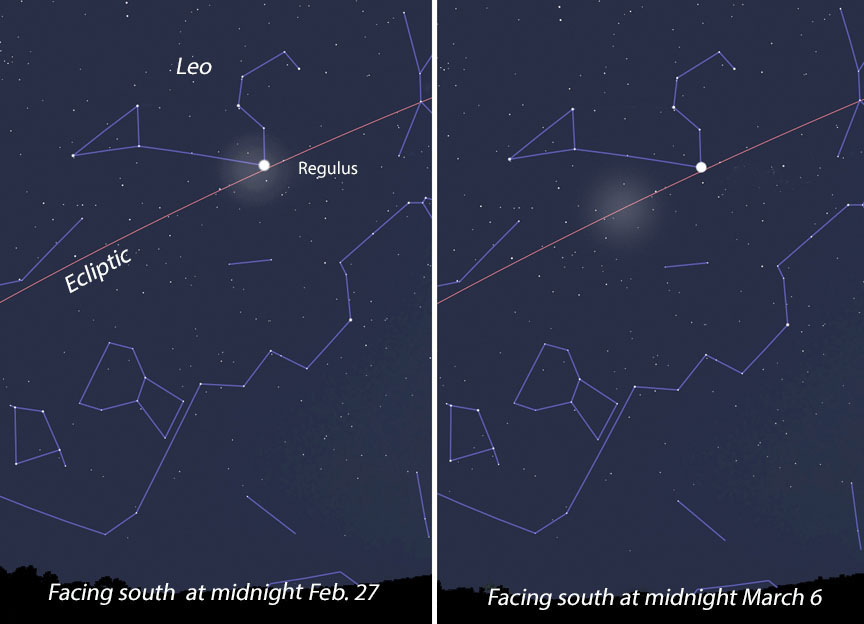
Stellarium
Bright is a relative term. I'd rate the gegenschein equal to the fainter parts of the winter Milky Way. I include it on our tour because from now through about March 11th the sky will be moonless around midnight and the gegenschein will glow from a star-sparse region of the sky in Leo. Bright stars or planets can make this faint patch even harder to see, so this is a good opportunity. Use averted vision and don't disbelieve your eyes. You'll be looking for a diffuse glow (almost shapeless) centered on the ecliptic in Leo about the width of a balled fist held at arm's length. If you find it please let us know by leaving a comment.
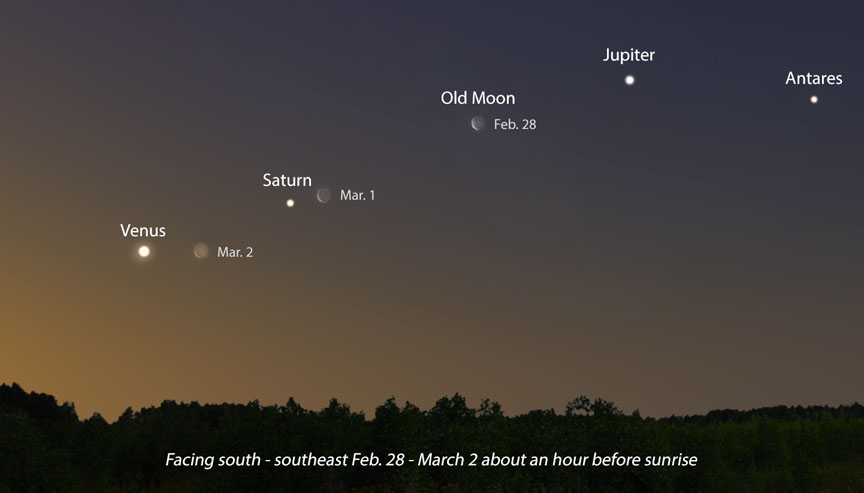
Stellarium
Keeping to our zodiacal theme, dawn watchers will see a lovely array of bright planets and the thinning Moon in the next few mornings. Plan to be out about an hour or so before sunrise. The waning crescent lies a few degrees to west of Saturn on March 1st and to the right of Venus on March 2nd. Both close approaches make for opportunities to see each planet just before and after sunrise in binoculars.
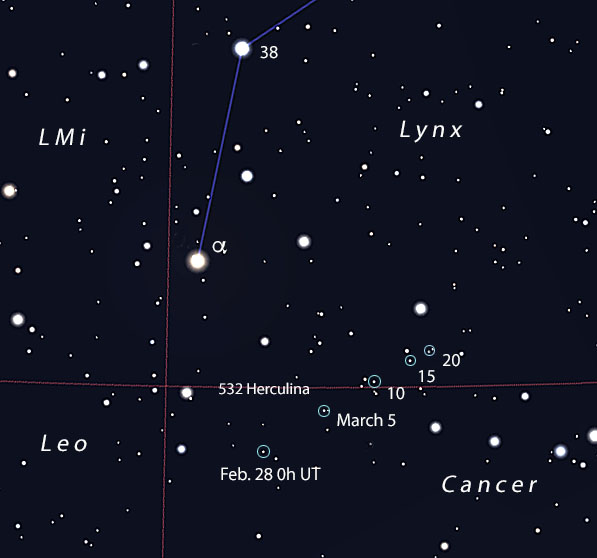
Stellarium
We'll finish up with a final detour, this time to the asteroid 532 Herculina, which lingers in Lynx near 3rd-magnitude Alpha (α) Lyncis. Herculina slowly fades from magnitude 9 to 9.5 over the next three weeks. From dark skies, observers might see it in 50-mm or larger binoculars. You wouldn't think a relatively high-numbered asteroid would be so bright, but Herculina is 225 kilometers across and ranks among the 20 largest main belt asteroids. Enjoy the night and all its delights!
 4
4








Comments
Rod
February 27, 2019 at 1:08 pm
Bob, the ecliptic before sunrise has indeed been great viewing. I went out early this morning in Maryland. I enjoyed viewing the waning crescent Moon in Ophiuchus and Jupiter close to 2 degree angular separation from the Moon early this morning. I viewed Jupiter with my telescope (could see belt clouds and Galilean moons at 31x) and with 10×50 binoculars, I was able to fit both in the binocular field view along with the star Xi Ophiuchi close to the lunar limb. I could not quite fit Jupiter and the Moon into the telescope FoV at low power. The Moon was in the corner, just out of sight, I could see the glow from it while looking at Jupiter and its moons. This was near 0545 EST. Very nice views this morning. Jupiter close to 5.47 au distance, the Moon near 392000 km distance and the star, Xi Ophiuchi about 57 light-years away. Glad you enjoy some good dark sky viewing.
You must be logged in to post a comment.
Bob KingPost Author
March 1, 2019 at 4:18 pm
Rod,
I so wished I'd seen Jupiter at dawn that morning. However, I did get to see it and the moon in binoculars more than an hour after sunrise when the sky cleared.
You must be logged in to post a comment.
Fabrice Morat
March 2, 2019 at 7:56 am
Hello Bob,
Subject : Gegenschein as a quality time marker...
If one day, you're lost in a island somewhere in the northern hemisphere with a begining of madness, of course you can have the latitude of the site with the north star but always by night, you can have the precise date in the year if you can accurately situate the central position of the gegenschein on the ecliptic. For example, on your photo of Paranal, with this southern Gegenschein in Pegasus (see the Great Square at the left), i can argue the probable date of october 9th after 0hTU. This photo was made in 2007 but i don't find the date of this Yuri capture for verification. From quite good sites, this exercise can be done nearly all the year except in june or december when milky way merges with the Gegenschein. I like to follow it in the year and with experience, you can judge variations in the size, form (more elliptic or round) and intensity. At the moment, I find it relatively round in Leo, large and diffuse, from La Palma island. Fabrice M.
You must be logged in to post a comment.
Bob KingPost Author
March 4, 2019 at 12:36 am
Fabrice,
Thank you very much for sharing your experiences with the gegenschein. I agree that its form is variable AND that it serves as faint, natural clock! At my higher latitude, I can see as far south as Virgo and not again until it appears in Aquarius.
You must be logged in to post a comment.
You must be logged in to post a comment.